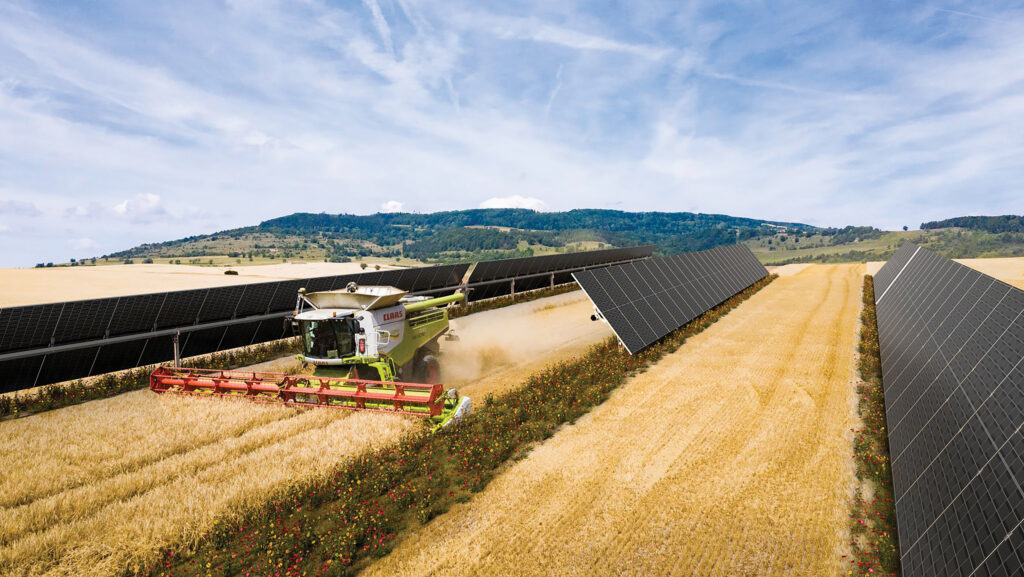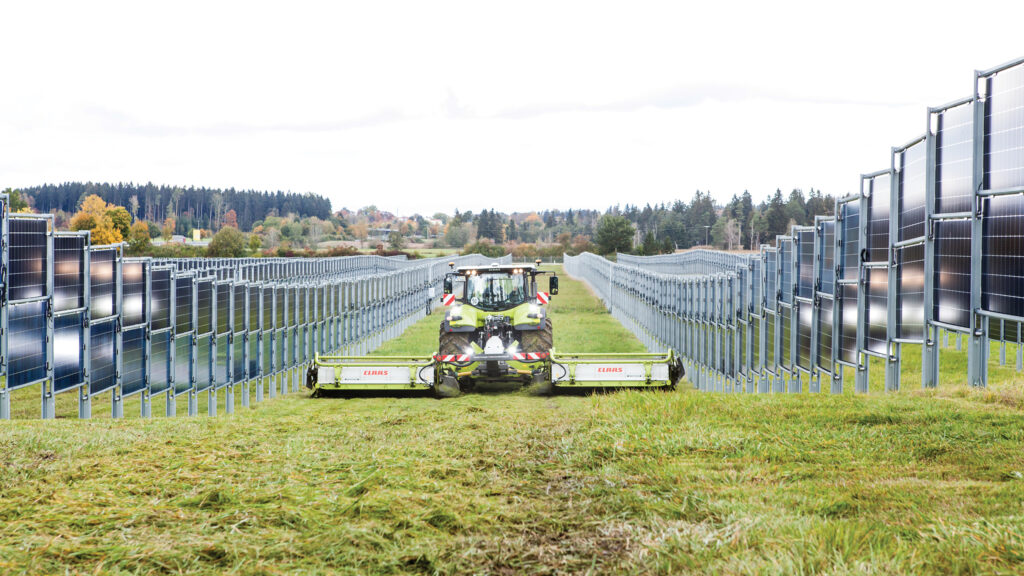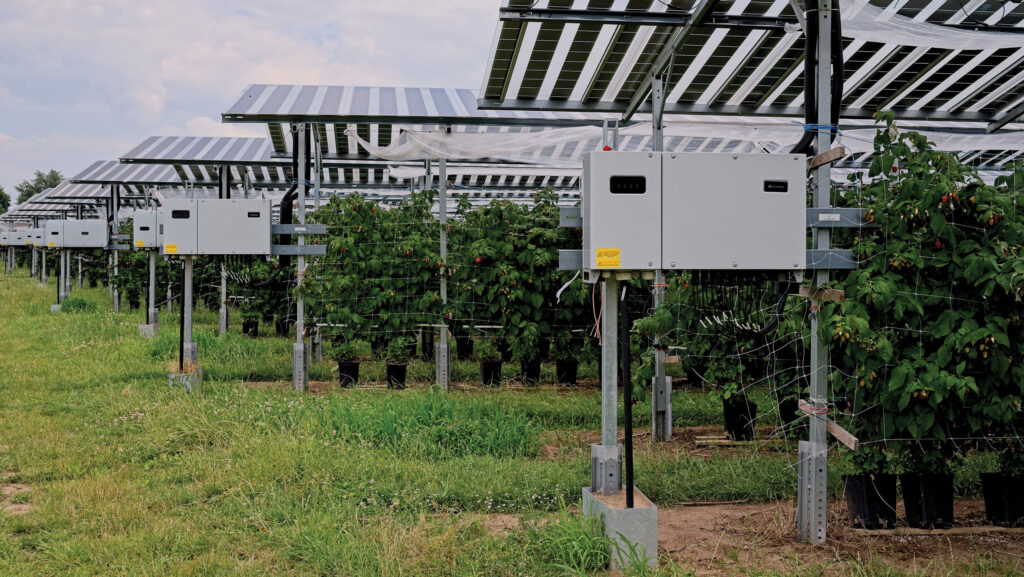Could agrivoltaics address the food v fuel debate?
 German company Baywa r.e.’s installation at Alhendin, Spain © Baywa r.e.
German company Baywa r.e.’s installation at Alhendin, Spain © Baywa r.e. The integration of cropping with solar panels is almost non-existent in the UK, but it is the basis of the concept of agrivoltaics.
First conceived by German physicists in the 1980s, it has become reality in many European countries, including Germany, France, Italy, Spain, the Netherlands, and further afield in China, Japan, and South Korea (see “Examples of Agrivoltaics developments in Europe”).
Types of agrivoltaics
- Fixed solar panels In rows with cropping in between
- Elevated solar panels 2.5-5m above ground, allowing cropping and field operations beneath panels
- Solar greenhouses Panels on the roof generate electricity to power inside operations or sell to the grid
- Dynamic/mobile systems Lightweight panels that can be moved around depending on season/cropping.
See also: Onshore wind turbines – prospects and advice
With ambitious UK government targets to generate 70GW of electricity from solar by 2035, and ongoing concerns about using productive farmland for such purposes, there could be considerable scope to adopt the approach here.
This is according to Cambridgeshire farmer, consultant, and AHDB board member Stephen Briggs, who planted 52ha of agroforestry (growing combinable crops and apple trees in the same fields) in 2008.
He believes the combination of solar alongside arable cropping could be a win for all involved and encourages farmers and solar developers to be open to the concept.
He first recognised the potential of agrivoltaics while studying for a Nuffield Scholarship on agroforestry in 2011.
“They both take the same principles of using multilayered systems to capture our primary resource, solar radiation.
“Simplistically, agroforestry works by ‘stacking’ perennials and annuals three-dimensionally, and agrivoltaics is much the same.
“A typical wheat crop only uses around 60% of the total solar radiation available, so there’s a fair amount of light we could capture for other purposes.”
Furthermore, once combinable crops begin senescing pre-harvest, the solar radiation is effectively not being used for a quarter of the year from July to September.
“At the point where there’s nearly maximum solar radiation available, we’re not using the biggest free input to our farming system.”
Installing solar panels alongside either arable or pastoral systems could be a really effective way of capturing some of that energy, he says.
What is holding it back?
As with all new connections, limited grid capacity remains a major barrier.
But so too is the “binary thinking” among policymakers, developers, planners and farmers, which has historically focused on using land for one purpose, be that food or energy generation, says Stephen.
“A question for the new government, and others, is why does it have to be a binary choice around food or energy when we can do both?”
Indeed, given the pressure on land-use and ongoing food versus fuel conflicts, he believes new schemes should integrate solar alongside food production, and doing so could even help meet planning requirements going forward.
Some European countries have now introduced legislation governing panel density, allowing land-use between the rows.
From a farming perspective, there are many practical considerations, but Stephen is confident the technology exists to integrate cropping with solar relatively easily.
“You need to drive straight and remember to turn the chaff spreader off on the combine, for example, but all these things are solvable.
“In essence, it is similar to a controlled traffic farming system, that some follow already.”
Can it work for all crops?
Any agri-PV system casts some shade on crops growing between or underneath panels and crops vary in their shade tolerance, with C4 plants such as maize being least tolerant.
Research also suggests cereal yields can be reduced by shading, but this could be mitigated through the system design and layout – rows of vertical panels might be preferable, for example.
Varieties may also differ in their responsiveness to shading.
Some crops such as onions, lettuce, potatoes, strawberries, and raspberries might suit shadier conditions better, while in sun-intense regions (beyond the UK), partial shade can increase output of vines or olives, for example.
Even in the UK, as the climate becomes more extreme, Stephen believes integrated systems could help improve resilience on farms, both economically by providing additional income, and agronomically.
Shade, for example, could reduce crop stress or soil moisture losses during very hot periods, while panels might shelter crops during windy weather.
Equally, the cooling effect of growing crops in and around solar panels can improve panel efficiency.
“There are still a lot of unknowns about what exactly agrivoltaics can do for climate resilience, but it’s something we’re investigating.”
Demonstrating agrivoltaic solutions
Someone else hoping to build greater awareness of the potential for agrivoltaics in the UK is Simon Tilley, director of Sustainable Hockerton Ltd (SHL).
This is a community benefit society born out of the Hockerton Housing Project, a not-for-profit sustainable living organisation near Newark.
The project began in the 1990s with construction of five earth sheltered houses.
SHL now features a community-owned 225kW wind turbine built in 2009, plus three rooftop solar arrays.
The company is hoping to install a 50kW ground-mounted solar array, to use as a demonstration site showing the potential for horticultural cropping between rows of solar panels.
The aim is to build the array in a standard layout and spacing to show cropping could be retrofitted around existing solar developments.
“As a community group, we never wanted to do field-based solar because of not wanting to take land away from food production.
But having seen solar developments marching forward, we need to show that if ground solar is to be built, it can be done better,” says Simon.
The project is still at the ideas stage, consulting with the community and looking at feasibility and grant funding, with the aim of applying for planning permission later this year.
“Although agrivoltaics has worked well elsewhere in Europe, it’s a different climate in the UK, so we’re working with Stephen Briggs to work out which crops might best suit us here and how to get the most from agrivoltaic systems.”
Alongside this, Simon is talking with local farmers and solar developers to highlight the potential of agrivoltaics.
This would apply for smaller-scale allotment, or regenerative farming-type systems retrofitted into existing solar sites, and larger-scale purpose built PV models designed and built to allow broad acre arable cropping between panel rows.
“There are lots of options, so we need to explore them all to see which model will work best in certain situations.
Developers seem receptive to incorporating these ideas, as they tick a lot of boxes in terms of sustainability, so we want to influence them to change their approach.”
One of those Simon is working with is the Great North Road solar project, which plans to install 800MW of solar generation capacity across 3,000ha near Newark.
“This is one of many other large-scale projects that will be needed to meet government targets.
“Solar farms are happening across many acres, so we need to improve them in terms of food production.”
Examples of agrivoltaics developments in Europe
Germany
The Fraunhofer Institute for Solar Energy Systems is the largest solar research institute in Europe and has been at the forefront of agrivoltaics technology.
This includes a 1ha research facility where different PV modules and orientations are being investigated to assess the impact on growth and yield of crops grown in agrivoltaics arrangements.
Elsewhere, Next2Sun offers agri-PV systems to farmers and investors, including lease arrangements where the landowner simply provides the land, through to joint ventures.

Forage and energy side by side at a Next2Sun project in Germany © Next2Sun
A core part of its system is the installation of “bifacial” vertical solar panels featuring solar cells on both sides which, when aligned east-west, aim to generate electricity mainly in the morning and afternoon or early evening.
Crucially, they have a smaller footprint than standard angled panels, so take up only about 10% of the field area, allowing farming to continue in between.
Next2Sun has plans to work with US solar company iSun on the first agrivoltaics plant in North America.
The 1.5ha site will feature 69 vertical bifacial solar modules in rows just over 9m apart, allowing crops such as carrots, beetroot, and saffron to be grown between the rows.
Spain
Agrivoltaics forms part of a recently constructed 85,000 panel solar project in Spain.
Built by German company BayWa, about 10% of the area is designed to allow farm machinery to pass between the panels, allowing conventional cereal production.
France
France In 2009, the National Research Institute for Agriculture, Food and the Environment (INRAE) began a joint project with French energy company Sun’R to develop agrivoltaics systems for a range of farming situations, including arable crops, market gardening, arboriculture and viticulture.
In 2017, this included a world-first for viticulture, when 4.5ha of vines were planted underneath controllable tracking solar panels at a demonstration site in southern France.
The Netherlands
A group of companies and researchers has developed a mobile solar array, the H2arvester, that can travel autonomously across fields.
Each 12×6m solar “car” moves slowly (10 m/hour) in a pre-defined direction. It is claimed that 2MW could be generated from a 10ha field without affecting crop production.

An installation over raspberries in the Netherlands © Jacopo Landi/Shutterstock
